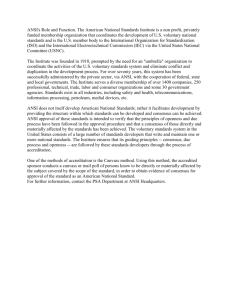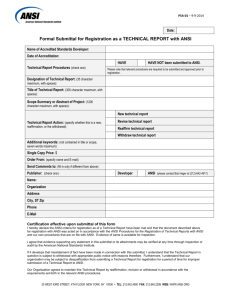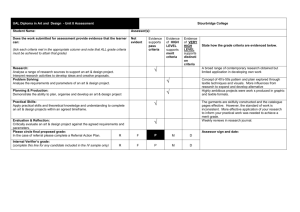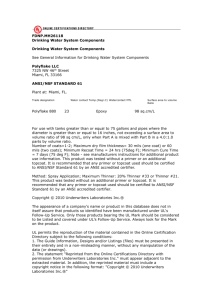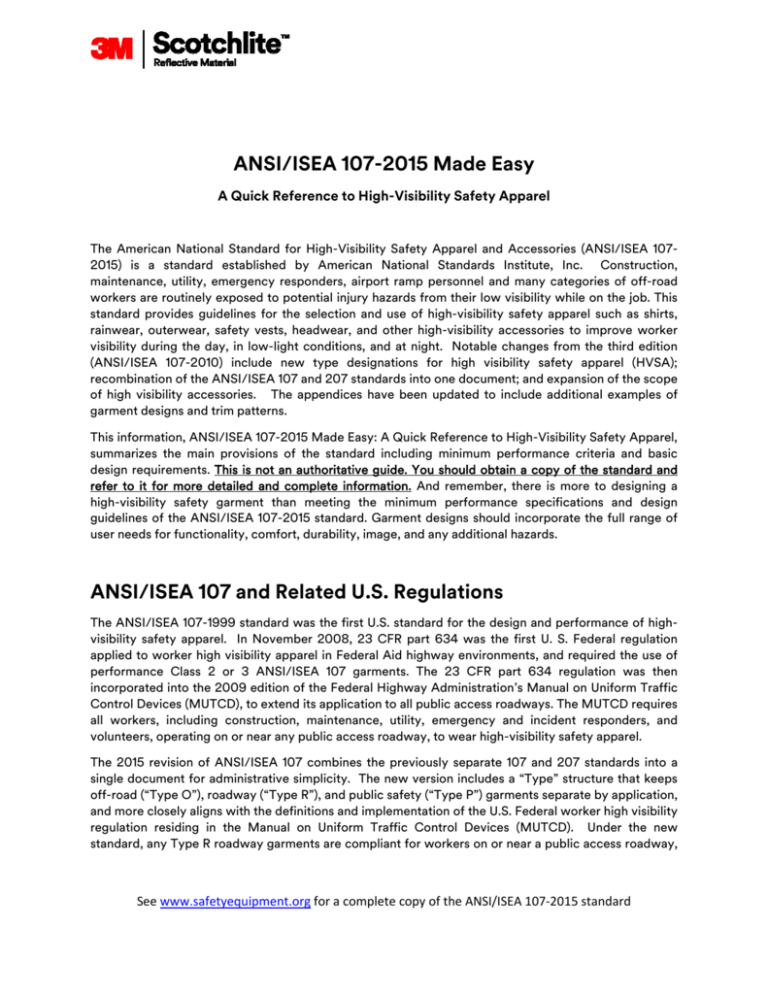
ANSI/ISEA 107-2015 Made Easy
A Quick Reference to High-Visibility Safety Apparel
The American National Standard for High-Visibility Safety Apparel and Accessories (ANSI/ISEA 1072015) is a standard established by American National Standards Institute, Inc. Construction,
maintenance, utility, emergency responders, airport ramp personnel and many categories of off-road
workers are routinely exposed to potential injury hazards from their low visibility while on the job. This
standard provides guidelines for the selection and use of high-visibility safety apparel such as shirts,
rainwear, outerwear, safety vests, headwear, and other high-visibility accessories to improve worker
visibility during the day, in low-light conditions, and at night. Notable changes from the third edition
(ANSI/ISEA 107-2010) include new type designations for high visibility safety apparel (HVSA);
recombination of the ANSI/ISEA 107 and 207 standards into one document; and expansion of the scope
of high visibility accessories. The appendices have been updated to include additional examples of
garment designs and trim patterns.
This information, ANSI/ISEA 107-2015 Made Easy: A Quick Reference to High-Visibility Safety Apparel,
summarizes the main provisions of the standard including minimum performance criteria and basic
design requirements. This is not an authoritative guide. You should obtain a copy of the standard and
refer to it for more detailed and complete information. And remember, there is more to designing a
high-visibility safety garment than meeting the minimum performance specifications and design
guidelines of the ANSI/ISEA 107-2015 standard. Garment designs should incorporate the full range of
user needs for functionality, comfort, durability, image, and any additional hazards.
ANSI/ISEA 107 and Related U.S. Regulations
The ANSI/ISEA 107-1999 standard was the first U.S. standard for the design and performance of highvisibility safety apparel. In November 2008, 23 CFR part 634 was the first U. S. Federal regulation
applied to worker high visibility apparel in Federal Aid highway environments, and required the use of
performance Class 2 or 3 ANSI/ISEA 107 garments. The 23 CFR part 634 regulation was then
incorporated into the 2009 edition of the Federal Highway Administration’s Manual on Uniform Traffic
Control Devices (MUTCD), to extend its application to all public access roadways. The MUTCD requires
all workers, including construction, maintenance, utility, emergency and incident responders, and
volunteers, operating on or near any public access roadway, to wear high-visibility safety apparel.
The 2015 revision of ANSI/ISEA 107 combines the previously separate 107 and 207 standards into a
single document for administrative simplicity. The new version includes a “Type” structure that keeps
off-road (“Type O”), roadway (“Type R”), and public safety (“Type P”) garments separate by application,
and more closely aligns with the definitions and implementation of the U.S. Federal worker high visibility
regulation residing in the Manual on Uniform Traffic Control Devices (MUTCD). Under the new
standard, any Type R roadway garments are compliant for workers on or near a public access roadway,
See www.safetyequipment.org for a complete copy of the ANSI/ISEA 107‐2015 standard and Type P public safety garments add a compliance option for emergency and incident responders.
As previously designated, firefighters may use retroreflective turnout gear compliant to NFPA standards
when exposed to flame, heat, and / or hazardous materials during emergency operations.
ANSI/ISEA 107-2015 focuses on the following:
• Design
• Requirements for Background and Combined-Performance Retroreflective Materials
• Photometric and Physical Performance Requirements for Retroreflective Materials
• Care Labeling
Definitions
Background material: Colored fluorescent material intended to be highly conspicuous, but not intended
to comply with the requirements of this standard for retroreflective material.
Retroreflective material: Material that reflects and returns a relatively high proportion of light in a
direction close to the direction from which it came.
Combined-performance material: A retroreflective material that is also a fluorescent material.
Declaration of Conformity: A statement by the manufacturer or supplier, based on a decision following
review, that fulfillment of the requirements specified in this standard has been demonstrated. (Appendix
D3)
High Visibility Safety Apparel (HVSA): Personal protective safety clothing intended to provide
conspicuity during both daytime and nighttime, and other low-light condition usage.
High Visibility Accessory: A high-visibility item or items that can help define the human form and, when
combined with movement, enhance nighttime conspicuity.
Photometric Performance: The effectiveness of retroreflective material in returning light to its source
and measured in terms of coefficient of retroreflection.
Flame Resistance: The property of a material whereby flaming combustion is prevented, terminated, or
inhibited following application of a flaming or non-flaming source of ignition with or without subsequent
removal of the ignition source.
Roadway: An area designed, or ordinarily used for the purposes of vehicular travel.
Accredited laboratory: A laboratory having a certificate of accreditation meeting the requirements
ISO/IEC 17025:2005 General requirements for the competence of testing and calibration laboratories
for the collection and analysis of data within the parameters of this standard.
Design
The ANSI/ISEA 107-2015 standard provides design guidelines and specifies the photometric
requirements, minimum amounts of component materials, colors, and placement to create garments
and headwear for the purpose of enhancing the visibility of workers. Refer to Section 6 of the standard
for more detailed information. The selection of components and classes of apparel should be made
based upon what is appropriate for the hazard and with the safety of the worker in mind.
See www.safetyequipment.org for a complete copy of the ANSI/ISEA 107‐2015 standard Component Colors
There are three different colors for background and combined-performance material from which to
choose: fluorescent yellow-green, fluorescent orange-red and fluorescent red. Users should consider
the work and natural environment to determine the most conspicuous color for daytime use. Is the
environment urban or rural, heavy foliage or desert? Are work zone devices and equipment yellow or
orange? Choose the fluorescent color that achieves the highest degree of worker contrast.
Garment Types and Classes
Three type designations for high visibility safety apparel are new to the ANSI 107-2015 standard. These
types will help the user to choose options according to work environment. This also made it easier to
combine ANSI 107 with the previous ANSI 207 classification and still keep the public safety options
separate from other occupational garments. The types are further broken down into classes 1, 2 or 3.
Type “O” garments are for occupational workers who are not required by MUTCD 2009 to wear highvisibility safety apparel, but may still work in an environment with moving equipment/vehicles and
accompanying struck-by hazards, and visibility is a concern.
Type “R” garments are for occupational workers who are exposed to roadway traffic and who work in
an environment with moving equipment/vehicles. This type designation and the classes within it now
describe and make up the PPE that is federally mandated per the MUTCD 2009.
Type “P” garments are derived from the previous ANSI 207 standard. This type designation gives
additional options for fire, police, and EMS personnel who have other potential hazards that require
them to access equipment on their person. Type P garments differ from type R garments mainly in the
area requirements for background material.
Three classes of high-visibility safety apparel help the user to choose the proper garments based on
expected work environment risks. The classes state the minimum amount of background and
retroreflective material, and specify placement of retroreflective material as well as any technical
requirements for garment design.
Retroreflective Material Placement
Class 1 and 2 garments, such as vests and T-shirts, and Class 3 garment configurations, such as a vest
with Class E pants ensembles, coveralls, outerwear and rainwear should achieve the following:
• Use of retroreflective band widths appropriate for the garment class
• Provide 360° visibility with horizontal gaps of 50mm or less
15 cm • Garments without reflective material encircling the sleeves are required to
(5.9 in)
have 150 cm2 (23.25 in2) of reflective material in the shoulder area, to
provide 180º visibility of the wearer. Shoulder area is defined as measuring
15 cm (5.9 in) down from the shoulder high point, on the front and back of
the garment. The requirement of 23.25 in2 is the total amount of reflective
material required in the shoulder area including the front and back of the garment, e.g., shoulder area
retroreflective material amount front + rear 23.25 in2.
See www.safetyequipment.org for a complete copy of the ANSI/ISEA 107‐2015 standard • Appropriate separation distances of vertical and horizontal bands placed on the torso, sleeves and
trouser areas.
• Appropriate retroreflective band placement and garment design.
• In addition to trim, retroreflective patterns such as logos, design icons, or identification text may
contribute to the maximum area requirements specified in Table 1.
• A footnote in Table 1 of ANSI/ISEA 107-2015 includes a background fabric area reduction exception
for the smallest garment offered in each design, to better accommodate smaller sized workers.
Fabric and Reflective Requirements Broken Down by Type and Class Garment Type Designation
Type "0"
Type "R"
Type "P"
Off‐road
Roadway
Fire, Police, EMS Personnel
Performance Class
Class 1 Class 2
Class 3
Class 2
Class 3
Background Material Amounts 217 in 2
775 in 2
1240 in 2
450 in 2
775 in 2
Reflective Material Amounts 155 in 2
201 in 2
310 in 2
201 in 2
310 in 2
Width Minimums of Reflective Material 1" 1.38"
2"
2" 2"
Previous Standard and Class
(1" for split trim designs) (1" for split trim designs) (1" for split trim designs) (1" for split trim designs)
ANSI 107, Class 1 ANSI 107, Class 2 ANSI 107, Class 3 ANSI 207, PSV Shoulder
area
trim
provides
human
form
definition,
and
180º
visibility of the wearer
Separation
between bands
must be at least
2”
NEW!
Top
arm band
placed
between
elbow and shoulder
Trim > 2”
sleeve cuff
garment hem
Trim > 2” separation
between bands and at
least 2” from pant
bottom hem
Horizontal retroreflective
trim placed at >2” from
bottom garment hem,
provides 360º of visibility
See www.safetyequipment.org for a complete copy of the ANSI/ISEA 107‐2015 standard from
and
Requirements for Background and Combined-Performance Materials
Section 8 of the standard provides specifications for color, brightness, fabric strength, and moisture
resistance after various exposure tests.
• Background and Combined-Performance material needs to be tested for chromaticity /color and
luminance and/or brightness without preconditioning; and again for colorfastness after standard
cleaning processes and Xenon (UV light) exposure. Table 3 in Section 8 is now the requirement for both
background and combined-performance materials.
• Background materials must also be tested for colorfastness after crocking and perspiration tests.
• Other tests for background materials include testing for dimensional change (shrinking) after washing
and dry-cleaning, tensile strength, tear resistance, bursting strength of woven material and bursting
strength of knitted material.
• If the garment is intended to provide protection during rainfall, background materials also need to be
tested as water repellent, water resistant, and /or water proof. See Section 8.5 of the standard for
updated definitions.
Photometric and Physical Performance Requirements for Retroreflective and CombinedPerformance Materials
The standard specifies photometric and physical performance requirements for retroreflective and
combined-performance materials.
• Initial photometric performance is defined in Table 5 with a combination of 4 entrance, 4 observation,
and 2 orientation angles.
• All material must meet the minimum brightness requirements after tests for abrasion resistance,
flexing, folding at cold temperatures, variation in temperatures, influence of rainfall, and laundering.
When washing is indicated on the care label, the number of cycles shall be tested to the updated
laundry test standard ISO 6330 Method 6N, 60ºC. This replaces the previous milder ISO 6330 2A
wash method, and may impact the wash claims of finished garments.
• Combined-performance material must also meet the minimum luminance or brightness factors after a
Xenon exposure test (UV light).
Care Labeling, General Marking and Instructions for Use
Once all materials have been tested against performance requirements and certificates of compliance
from a third party testing laboratory have been issued, apparel manufacturers then assemble garments
according to the design guidelines in Section 6 of the standard for the appropriate type and class of
garment. Only after all the materials’ performance and design requirements have been met, can a
garment be labeled ANSI/ISEA 107-2015 compliant. Care labeling, general marking and instructions for
use are described in Sections 11 to 13 of the standard.
See www.safetyequipment.org for a complete copy of the ANSI/ISEA 107‐2015 standard Specific Marking
Marking includes, at a minimum, the following information:
• Manufacturer’s name or other means of identification.
• Item number or other identification of the specific style of
product.
• Size.
• This ANSI/ISEA standard name including year (ANSI/ISEA 1072015).
• Compliance with flame resistance can be indicated in one of 2
ways:
1. The letters “FR” on the label followed by the designation of the
ASTM or NFPA standard specification from the list of allowed
standards in Section 10.5.
2. Garments which fully meet the third party certification
requirements to NFPA 1977, or 2112, may use the separate label
indicated by the NFPA standard to indicate FR compliance.
• If garment is not flame resistant, label must include the statement, “This garment is not flame resistant
as defined by ANSI/ISEA 107-2015.”
• Pictogram showing the garment Type, Class and Level of performance for the retroreflective material.
Universal pictogram can be used or a pictogram that represents the garment being labeled.
• Maximum number of wash processes (i.e.: Max 50).
Answers To Some Frequently Asked Questions:
1. Are there other differences between the ANSI/ISEA 107-2010 and ANSI/ISEA 107-2015
standards? Yes. There are additional differences between the 2010 and 2015 editions of this standard.
See the companion document, “Highlights of ANSI/ISEA 107-2015 What’s Changing,” or talk with a 3M
Application Engineer for additional information.
2. Do U.S. Federal regulations require the use of high-visibility safety apparel for construction
workers working in highway/construction work zones at risk of being struck by traffic? Yes. Section
6D.03 of the 2009 Manual on Uniform Traffic Control Devices (MUTCD) specifies the kinds of high
visibility safety apparel which workers must use when operating on or near public access roadways.
3. Does this edition of the standard replace the 2010 edition? ANSI 107-2015 replaces the ANSI 1072010 version as the current version of the standard. If and when the Federal Highway Administration
issues a letter of interpretation accepting ANSI/ISEA 107-2015 garments as performance equivalent to
previous additions, then 2015 garments may be used to comply with the MUTCD requirements as
explained in the letter; the letter may be hoped to issue a month or two after the standard is released.
4. What version of ANSI 107 does MUTCD 2009 require? For all workers, including emergency
responders, within the right-of-way who are exposed either to traffic or to work vehicles and
construction equipment within a Temporary Traffic Control zone, MUTCD 2009 Section 6D.03
See www.safetyequipment.org for a complete copy of the ANSI/ISEA 107‐2015 standard requires Class 2 or Class 3 garments of ANSI/ISEA 107-2004 or equivalent revisions, such as
ANSI/ISEA 107-2010 or ANSI/ISEA 107-2015 as noted in question 3. Section 6E.02 requires ANSI/ISEA
107-2004 Class 2 or 3 for flaggers- FL orange-red or yellow green are required background colors.
Section 7D.04 requires ANSI/ISEA 107-2004 Class 2 for Adult Crossing Guards1.
5. Can NFPA 701 be used to claim flame resistance for an ANSI 107-2015 garment? No.
6. I have only found larger-sized garments that meet the standard. I have smaller workers that need
appropriately fitting garments to work safely. Is this being addressed? Type R “roadway” Class 2 and
Class 3 garments have an allowance for a reduced minimum area requirement, but only for the smallest
size garment that is offered in a given design. This should allow for better accommodation of garment
sizing for smaller workers.
7. Why were the ANSI/ISEA 107 and ANSI/ISEA 207 standards combined into one document?
When standards are updated, the references they contain are also updated. When ANSI/ISEA 107 and
207 were on a staggered revision schedule it created a situation where materials compliant to both
were subject to different test methods for the same properties. Similarly, improvements in one
standard had to wait for carry over into the other. Bringing the standards into the same document
makes them easier and less complicated to implement.
8. What is the new structure of the combined ANSI/ISEA 107 and 207? 107 and 207 were separate
because the types of garments they specify have different attributes and requirements among their user
groups. A new garment “type structure” for high visibility clothing was implemented to create a
framework that kept them separate by intended application and for specification purposes, but made it
easy to determine which garments would meet MUTCD regulatory requirements. Type O “off-road”
garments are a new designation for workers operating in environments with vehicle or machinery
struck-by hazards, but no exposure to roadways. Type R “roadway” garments are suitable to meet the
MUTCD regulatory requirements. Type P “public safety” garments can be used by emergency and
incident responders and law enforcement personnel to comply with the MUTCD.
9. If a garment passes Type R requirements does it automatically pass Type O and P? Will it need to be
labeled with all designations, i.e., Type O, R, and P? A garment only needs to be marked for the claim
the manufacturer is making. Sometimes manufacturers claim compliance to multiple standards or
requirements, and can include separate conforming labels as an indication.
10. Has the treatment of accessories changed? Accessories are now more broadly defined to include
gloves, hats, bandanas, etc., and may be labeled as ANSI/ISEA 107 compliant. The new requirements
give conscientious accessory manufacturers the option of using good quality ANSI/ISEA 107-2015compliant high visibility materials and labeling as such through self-certification, to better differentiate
themselves from look-alike accessories that may appear “high visibility,” but use generic non-compliant
materials which may be of lesser quality.
11. Do the high visibility materials on compliant accessories count toward area minimums together
with garments if they are worn together? No. The accessory category was expanded to provide
safety professionals with more options to help workers be safe and comfortable in high visibility gear,
while at the same time being able to demonstrate that their safety program goes “above and beyond”
minimum legal requirements, by issuing certified compliant accessories built with high quality materials.
12. Are “biomotion” design concepts integrated into standard requirements? Garments with sleeves
or pant legs are required to include high visibility materials in these key areas, because they have been
shown in multiple scientific studies to be the most effective placement to enhance conspicuity.
1
Manual on Uniform Traffic Control Devices 2009 Edition pages 564-566, 745
See www.safetyequipment.org for a complete copy of the ANSI/ISEA 107‐2015 standard Look to 3M
When it comes to high-visibility reflective trim, 3M is an industry leader in providing information,
research, reflective applications advice, and garment design consultation. You and your workers can
look to 3M for quality, reliability, and product support. Our sales and technical support staffs want to
serve as a resource for your selection of components and garment design, planning and executing a
visibility demonstration, and developing a garment specification. For more information on how 3M can
help you with your high-visibility safety apparel needs, call 800-328-7098, Ext.2.
This summary of ANSI/ISEA 107-2015 was prepared by 3M PSD and does not represent an official or
legal or necessarily complete interpretation of the standard. If specific questions rise, the standard itself
should be reviewed and relied on rather than this summary. A copy of this standard can be obtained at
www.safetyequipment.org.
3
Personal Safety Division
3M Center, Building 0235-2W-70
St. Paul, MN 55144-1000
3M.com/PPEsafety
For More Information
Technical Assistance 1-800-243-4630
Hours of Operation: M-Th 8am - 6pm, Fri 8am - 4:30 pm CST
© 3M 2016. All rights reserved.
February 2016
3M.com/Scotchlite
See www.safetyequipment.org for a complete copy of the ANSI/ISEA 107‐2015 standard

